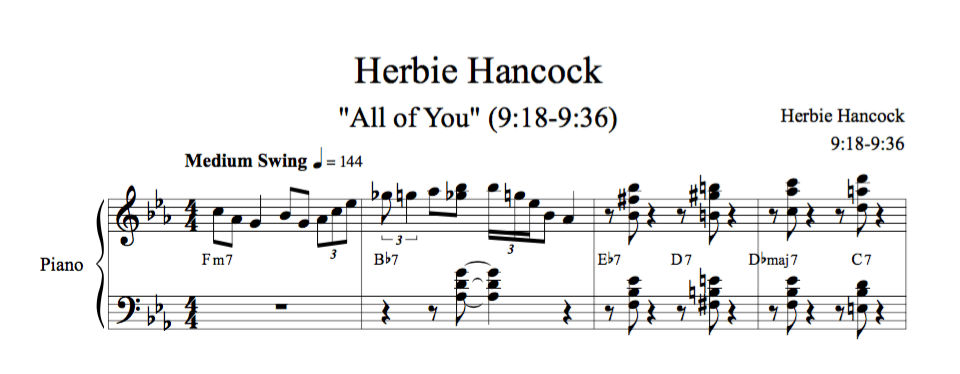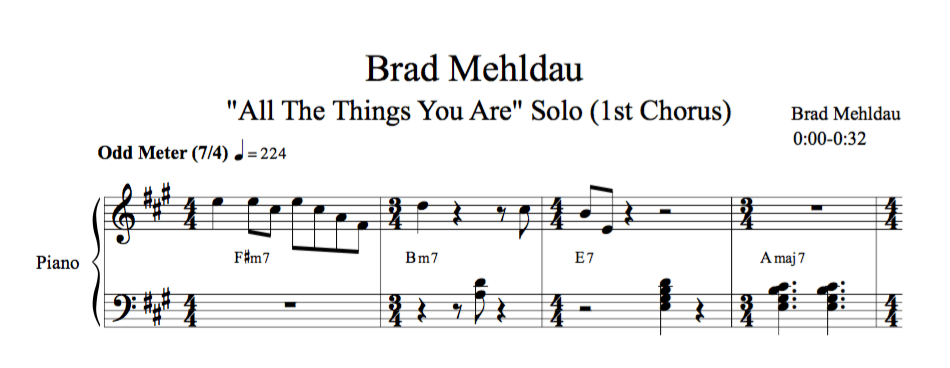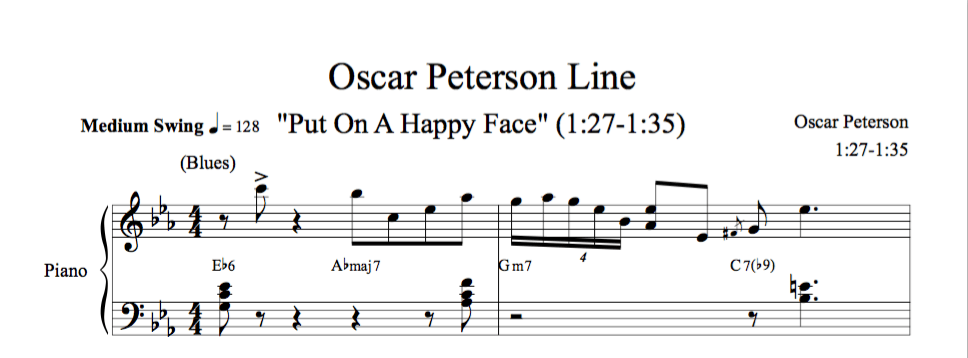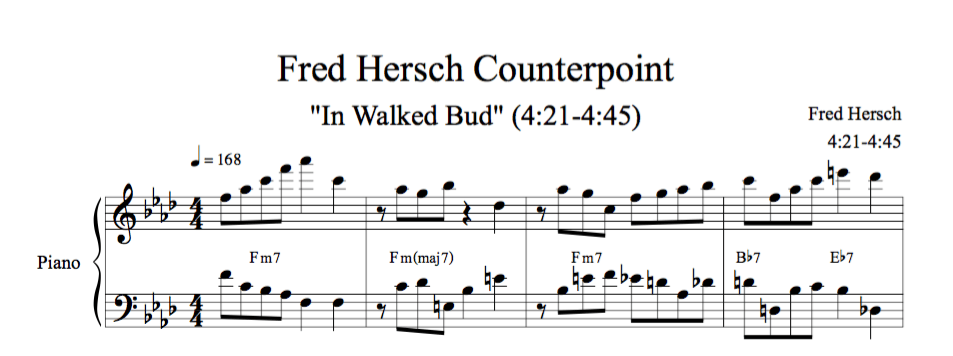Oscar Peterson
Oscar Peterson, the “Maharaja of the keyboard,” was one of the pioneers of jazz piano who innovated a style unique to him.
- He was a virtuoso, able to execute 16th note bop lines flawlessly while maintaining impeccable time.
- His phrasing was central to his style; he possessed a light touch that allowed him to take full advantage of his digital dexterity, and a way of accenting notes that contributed to his swing feel and enabled him to express a range of emotion through his technique.
- While his technical facility awed many, it was his swing feel and sense of groove that made his music dance.
- Oscar is a great source for blues vocabulary. His improvisations consisted of bebop phraseology and a strong emphasis of the blues, which were the major hallmarks of his melodicism.
- He was also adept at various pianistic devices such as: stride piano, block chords, and double octave melody lines (playing linear lines in both hands simultaneously, two octaves apart).
- Furthermore, Oscar is a great source of ideas for arranging in a small ensemble setting; he wrote complex arrangements for jazz piano trio that consisted of rhythmic hits, intricate intros, outros, and interludes, and chamber-like passages (often times written out bass lines that doubled the piano left hand), which can be heard in his arrangement of “Put On A Happy Face”.
Recommended Listening: “Oscar Peterson Trio” Live At CBC Studios 1960, “Oscar Peterson” Solo (1972)
Kenny Barron
Kenny Barron is one of the masters of mainstream jazz piano, known for being a lyrical soloist and sensitive accompanist.
- He is a great source for bebop vocabulary.
- As one of the major performers of the Great American Songbook and one of the most recorded jazz artists, you will likely be able to find a recording of Kenny Barron playing most jazz standards, either as a sideman or a leader.
- Thus studying Kenny Barron will help you understand how to apply this language in the context of jazz standards.
- As one of the major performers of the Great American Songbook and one of the most recorded jazz artists, you will likely be able to find a recording of Kenny Barron playing most jazz standards, either as a sideman or a leader.
- Often underrated and under-appreciated as a soloist, Kenny combined his unique sense of lyricism with bebop phraseology to tell a story.
- Another important thing to take-away from Kenny’s playing is how to build a solo, as opposed to simply playing everything you know. As Kenny says, “Solos have hills and valleys”. Since he doesn’t resort to licks and builds his solos one phrase at a time, there is a natural flow and honesty that comes across through his solos.
- His playing has not only matured, but evolved with the changing of the times as well.
- Kenny is also a great source for learning how to accompany horn players.
- He is most known for his work with Dizzy Gillespie and Stan Getz, with whom he also developed an appreciation for Brazilian and Latin music.
- There is a reason he was and continues to be one of the most sought after sidemen- because he knows how to “provide a bed for the soloist”.
- As a comper, Kenny provides a perfect balance of feeding the soloist ideas– melodically, harmonically, or rhythmically– while remaining sensitive to the soloist.
Recommended Listening: “Stan Getz Quartet” The Final Concert Recording (1990), “Stan Getz & Kenny Barron” People Time (1991), “Kenny Barron” Live at Maybeck Recital Hall, Vol. 10 (1991)
Herbie Hancock
Herbie Hancock is arguably one of the most versatile and open-minded musicians of all time. He had an adventurous spirit and an incredible curiosity that filtered through his music and his career.
- While others tend to find their niche and latch onto it, Herbie continues to push the artistic envelope as he believes, “The hip stuff is outside is the comfort zone!”
- That explains why his career had so many different periods ranging from straight-ahead jazz, to funk, electronic music, Classical music, Latin jazz, avant-garde, hip-hop, and even collaborations with pop artists.
- He was one of the first to embrace synthesizers and the use of technology in music.
- In the jazz world, he has been involved in various projects, most notably as sideman playing alongside Wayne Shorter, Miles Davis’ Second Quintet, and as a leader with the Head Hunters, the New Standard Quintet, and the Herbie Hancock Trio.
- A major concept to learn from Herbie is how to tell a story.
- As an improviser, accompanist, and composer, he was one of the greatest storytellers.
- He played with a certain freedom and open-mindedness that allowed him to go in any direction musically based on the moment and his surroundings.
- He was a pianist who truly played what he heard.
- As an improviser, he embraced dissonance and was a primary architect of the post-bop sound.
- As an accompanist, Herbie was in demand because of his abilities to listen and interact, rhythmically and harmonically, with the soloists who he comped behind- sometimes matching the soloist’s idea, at other times leaving space, and sometimes even suggesting a new idea.
- A true harmonic genius, he was a master of reharmonization, in his comping as well as his improvisation.
- Herbie was also a prolific composer, as many of his compositions have become jazz standards, including: Dolphin Dance, Maiden Voyage, Speak Like a Child, Cantaloupe Island, Watermelon Man, One Finger Snap, among others.
Recommended Listening: Takin’ Off (1962), Empyrean Isles (1964), Maiden Voyage (1965), “Miles Davis Quintet” My Funny Valentine (1965), Head Hunters (1973), Herbie Hancock Trio (1977), The New Standard (1996)
Transcription:

Fred Hersch
Fred Hersch is one of my personal favorite pianists because his playing is very thoughtful, yet emotional at the same time- a rare achievement in jazz and art in general.
- He is a master of the solo piano setting, able to effectively turn a jazz standard into a spontaneous piano sonata.
- Fred is one of the most recent innovators in modern jazz piano because of his sophisticated style of playing and particularly for being the first to infuse counterpoint in jazz.
- He is a great source for counterpoint and contrapuntal movement, which can be heard on his trio recording of his arrangement of “You and the Night and the Music”, which features his contrapuntal improvisation.
- As a writer, Fred has a distinctive compositional voice that can be heard in his compositions: Whirl, Pastorale, Song Without Words: #1 Aria, Song Without Words: #4 Duet, Echoes, among others.
Recommended Listening: Songs Without Words (2001)
Brad Mehldau
Brad Mehldau is a benchmark of modern jazz piano, having influenced many of the young jazz pianists of our time. He is an innovator in all aspects of the music: melodically, harmonically, and rhythmically.
- He is a great pianist to check out for learning how to play melodic lines that are harmonically “outside” the chord changes.
- He often superimposes triads to achieve new harmonic possibilities
- Melodically, Brad often takes small fragments of melody and employs motivic development techniques such as rhythmic displacement and melodic sequencing to build his improvisations and compositions
- Rhythmically, Brad was one of the first to popularize odd-meter playing in a straight-ahead context, which can be heard on:
- his recording of “All The Things You Are” (in 7/4)
- his recording of “I Didn’t Know What Time It Was” (in 5/4)
- His fluency and freedom with odd time signatures allows him to play “over the barline” while always maintaining the pulse.
- A student of Fred Hersch, Brad also has a strong sense of hand independence that enables him to incorporate counterpoint and contrapuntal movement in his improvisations.
Recommended Listening: Art of the Trio Vol. 1 (1997), Largo (2002)
Transcription:

Keep in mind that this is not a ranking. These are just 5 of many important jazz pianists, and 5 who have exerted tremendous influence on my playing that I wanted to share. This is not to take away anything from: Bill Evans and his harmonic palette, McCoy Tyner and his innovative approach to improvisation using pentatonics, Erroll Garner and his unique playing style, Ahmad Jamal and his use of space, Bud Powell the father of bebop on the piano, Art Tatum and his virtuosic solo playing, Mulgrew Miller, Chick Corea, Thelonious Monk, Hank Jones, Tommy Flanagan, Nat King Cole, Keith Jarrett, Red Garland, and many others. One thing in common about all of these pianists is that they all had a distinctive style of playing in regards to swing feel and phrasing, as well as a unique melodic, harmonic, and rhythmic vocabulary so that if you were blindfolded, you would easily be able to identify one from the other. Spend some time and learn what makes each of them sound like them! Remember, you can always learn something from everybody.
Bijan Taghavi is a pianist, composer, and educator currently based in New York, NY. For more information visit http://www.BijanJazz.com.

















One Response
Nice list. Some I was unfamiliar with and listened to on Youtube for the first time. Beautiful music.